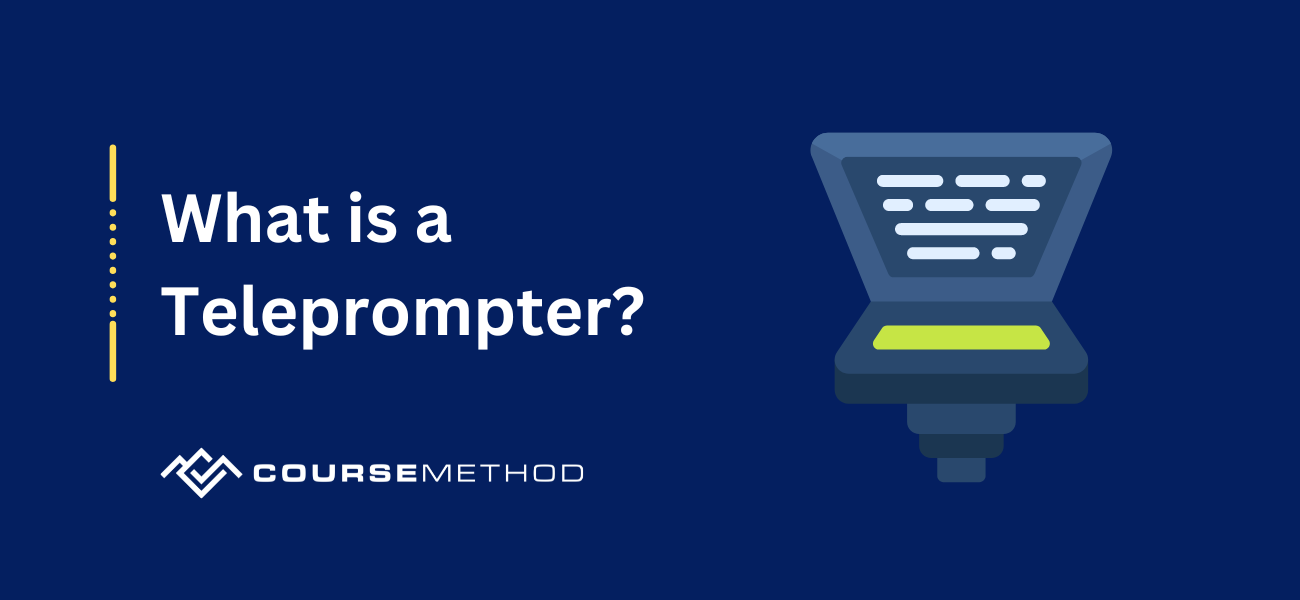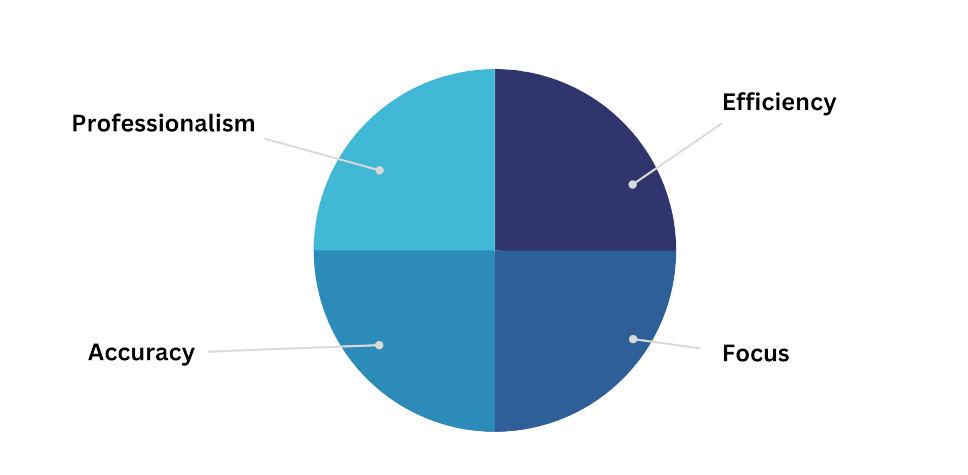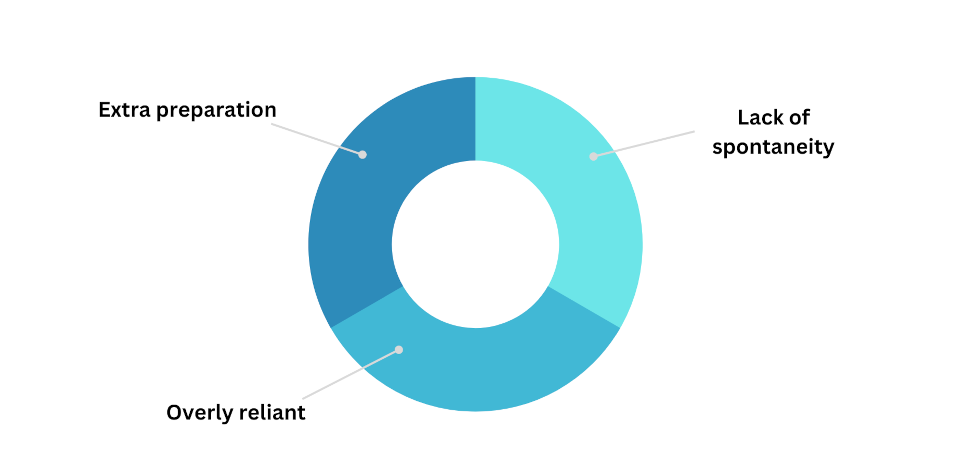Our content is reader supported, which means when you buy from links you click on, we may earn a commission.
What is a Teleprompter: Pros and Cons + How to Use One

As an online course creator, you know that having a great script is essential for delivering a compelling and engaging presentation. But memorizing long passages of text can be difficult, and it’s easy to lose your place if you make a mistake. That’s where teleprompters come in.
Teleprompters are devices designed to help presenters read scripts without missing a beat or struggling with memorization. With the correct teleprompter setup, you can confidently deliver smooth presentations—and even make editing on the fly easier than ever before.
What Is the Purpose of a Teleprompter?
Since it was first invented in 1948 by Hubert Schlafly, the teleprompter has been used by presidents and other public speakers to deliver smooth speeches confidently. The technology works by projecting a script onto a two-way mirror so the speaker can see it while looking directly into the camera lens.
By reading from the prompter instead of memorizing their lines, speakers can stay on message and convey their messages more clearly—with minimal risk of flubbing a line or getting lost in the material.
Today, teleprompters are becoming increasingly popular among online course creators. With the correct setup, you can easily create engaging videos that keep your audience’s attention throughout.
You won’t have to worry about forgetting your lines, and you’ll be able to maintain a consistent pace that makes it easier for viewers to follow along. Plus, if you make a mistake or want to edit on the fly, all you have to do is make changes in the script—no need to start over from scratch.
Pros of Using a Teleprompter
Using a teleprompter can be an invaluable tool for content creators, especially those working in television and film.

Here are some of the key benefits:
- Efficiency: Teleprompters save time and provide a consistent delivery of content—ensuring the message is delivered exactly as intended, regardless of how long it takes to perform or record the material. This can help ensure that all editing is done quickly, saving time and energy for other tasks.
- Focus: Content creators who use a teleprompter can concentrate on their performance without worrying about knowing their lines or memorizing them perfectly every time. Knowing that you have your script in front of you helps to center your focus on delivering an engaging performance rather than worrying about getting lost in the words being spoken.
- Accuracy: A teleprompter ensures that you never stumble over a word or phrase because it keeps you on track with the exact words written by the author/creator. This helps ensure accuracy across multiple mediums, from radio scripts to YouTube videos, and lets viewers know they’re getting reliable information from experienced professionals.
- Professionalism: Using a teleprompter implies professionalism and experience that shows viewers or audiences that you take your job seriously and are prepared to deliver content accurately without any mistakes or errors appearing in the finished product.
For this reason, many news networks and studios require their talent to use a teleprompter for all presentations or broadcasts to ensure consistency and accuracy for their audience members.
Cons of Using a Teleprompter
Using a teleprompter for content creation can be a double-edged sword. While it does offer a great way to ensure the accuracy of your words, it also comes with some potential drawbacks.

1. Lack of spontaneity: One of the main cons of using a teleprompter is that it can take away from the spontaneity that content creators often seek. When you’re reading from a script written and laid out in advance, it may come across as too rehearsed or robotic.
Content creators constantly strive for an organic feel to their work; utilizing a teleprompter can undermine that. Additionally, if you are presenting material live, there can be issues with maintaining the pacing of your delivery when reading from a script.
2. Overly reliant: Another potential problem with using a teleprompter is that you can become overly reliant on it. Relying solely on the prompter means having less control over what gets said and how it’s said.
For example, there are specific nuances or moments where you may want to ad-lib but cannot because the prompter won’t allow deviating from its designated script, even more so if there’s little room for improvisation within the set parameters of what you plan on saying due to time constraints or other reasons dictated by content creation requirements.
3. Extra preparation: Finally, using a teleprompter requires extra preparation and setup before recording or broadcasting begins and technical maintenance during use since they need special software and hardware to function correctly.
That increases your workload substantially and takes up precious time while also requiring additional equipment rentals that add to the expenses associated with creating content via this method.
What Are the Different Types of Teleprompters?
There are three main types of teleprompters: presidential, floor or stand, and camera-mounted. Here are some of the significant differences between them.
Presidential Teleprompter
Presidential teleprompters are the type most commonly used by public speakers and politicians. They work by projecting a script onto a two-way mirror in front of the speaker, allowing them to quickly read the text without looking away from the camera.
Floor or Stand Teleprompter
Floor or stand teleprompters are designed for use in smaller venues, such as classrooms and meeting rooms. They consist of a large monitor mounted on a stand, which the speaker stands behind to read their script.
Camera-Mounted Teleprompter
Finally, camera-mounted teleprompters are designed to be used with video cameras. They typically consist of a small monitor mounted directly on the camera. It can be operated remotely via a laptop or tablet.
What Is a Teleprompter App?
Over the past few years, teleprompter apps have become increasingly popular. These apps allow you to project a script directly onto your tablet or smartphone so you can easily read it without needing additional equipment.
The great thing about teleprompter apps is that they are usually effortless to set up and use, making them perfect for those who need a quick and cost-effective solution.
For online course creators, using a teleprompter app is a great way to ensure that you stay on-topic and deliver your lessons in an organized manner. With its many benefits, a teleprompter app can help you save time, maintain consistency, and give your lessons more effectively.
Parrot Teleprompter
One of the best teleprompter apps on the market is Parrot Teleprompter. Its simple and intuitive interface makes it easy to set up and start using immediately. It also has various features that make it perfect for online course creators. This includes the ability to set multiple scripts, control the speed of your script, and add pauses while delivering your presentation.

Here are some of my favorite features:
- Make scrolling through the landscape and mirrored mode scripts a breeze with adjustable speed, text size, and foreground/background colors.
- Type or edit your script directly within the app or access it from DropBox.
- Take full advantage of remote control capabilities and enjoy unlimited scripts with looping settings for quick production.
For online course creators looking to save time and deliver their lessons efficiently, Parrot Teleprompter is a great tool to have in your arsenal.
How To Write a Script for a Teleprompter?
Once you’ve decided to use a teleprompter for your online course, writing your script is next. Writing a good teleprompter script takes practice, but here are some tips to help you get started. 
Keep It Short and Sweet
To ensure you keep your script succinct and sweet, there are some tried-and-true strategies. One is to break down every point into its smallest possible parts, so you’re only writing what’s essential. Avoid repetition; if you want to emphasize something, find another way to do it without saying the same thing twice.
Finally, reading your text aloud as you write will help weed out overly flowery or convoluted language that takes too long to process when spoken.
Speak Conversationally
You can create natural dialogue and captivate viewers by speaking conversationally when scripting. Before you start scripting, imagine yourself engaged in conversations with a close friend or family member. This will help capture the genuine emotion of what you are trying to communicate, and it’s often easier to speak casually than write formally.
Words like “you,” “we,” and “I” establish a connection with the audience whom you are addressing during programming. Be consistent with the tone of your voice throughout the script so that listeners feel comfortable with your words – this creates an inviting atmosphere that makes it enjoyable for viewers and yourself.
Bring Your Script to Life
One key element is the tone of voice in which the script will be read. While it’s essential to be natural, basing your delivery on an enthusiastic inflection will help draw viewers in and keep them engaged with what you’re saying. Additionally, you can use personal stories or anecdotes to break up sections of the text. It will also help you create a deeper connection with viewers.
Act as if you’re having a personal conversation with each viewer. Let the audience become part of the story by reducing the divide between speaker and listener. If done correctly, your words will carry more weight, and viewers will connect with your message that much easier.
Conclusion
Teleprompters can be an excellent tool for online course creators who want to save time and deliver their lessons more effectively. With the right teleprompter app, you can easily set up and use a teleprompter to help you stay on-topic and keep your viewers engaged.